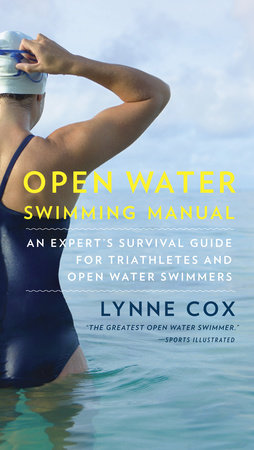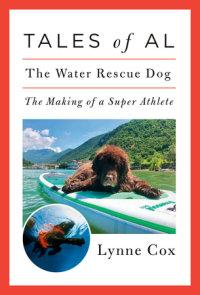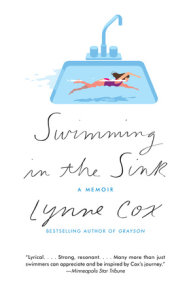

Open Water Swimming Manual
By Lynne Cox
By Lynne Cox
By Lynne Cox
By Lynne Cox
Category: Sports | Exercise | Science & Technology
Category: Sports | Exercise | Science & Technology

-
$16.95
Jul 30, 2013 | ISBN 9780345806093
-
Jul 30, 2013 | ISBN 9780345806109
YOU MAY ALSO LIKE

The Kids Are All Right

Guys in Suits

Outside In

The Tin Can Tree

The Might Have Been

The Ex-Mrs. Hedgefund

Talk Before Sleep

The Kid Who Batted 1.000

The Psycho Ex Game
Praise
Praise for Lynne Cox’s Open Water Swimming Manual
“A paean to outdoor immersion. . . . [Cox] has channeled her vast expertise on the dangers, joys and logistics of open water swimming into a new book aimed at the exploding ranks of triathletes and other swimmers who are escaping the safe confines of pools. . . . The publication could hardly be better timed. A steep rise in the popularity of triathlons has been swelling the ranks of open water events. . . . [Cox] tempers vision and enthusiasm with methodical, unstinting effort.”
—Andrea Kannapell, The New York Times
“Lynne Cox’s books are the works of a singular mind. That was true for the best sellers Swimming to Antarctica and Grayson, and it is true for her new book, Open Water Swimming Manual, a 300-page paperback instructional that is the most unlikely page-turner you could put on your summer reading list. She’s written a sort of fantasy in which you, the reader, are the protagonist. You can’t swim half a mile? Cox will put you on a program to swim 10! . . . Cox’s Open Water Swimming Manual could do for long-distance swimming what Jim Fixx’s The Complete Book of Running did for the American jogging movement in 1977.”
—Sports Illustrated
“Lynne Cox is an artist of the open water. No one knows more about swimming’s beauty and skill than this great champion, or could describe it with such clarity and grace. Every sport—every art—should have a book like this and a guide like Lynne Cox.”
—Christopher McDougall, author of Born to Run
Table Of Contents
Table of Contents
Introduction
Part One: How to Begin
Chapter 1: Beginnings
Allure of the Open Water
Expert Sources & Credentials
Chapter 2: Equipment
The Swimsuit
Swimsuit Care
Chafing
Skin Lubricant Products
Treatment for Chafing
Sunscreen Products
Sunburn Prevention
Sunburn Treatment
Goggles
Swim Caps
Wet Suits
Swim Skins
Chapter 3: Finding an Open Water Swimming Coach and Group
Finding Specific Coaches and Groups
Chapter 4: Technical Skills for Open Water Swimming
Swimming Skills Required
Breathing Drills
Head Position in the Water
Feeling the Water to Swim Faster
Chapter 5: Research
Selecting a Training Area
Scouting/Walking the Workout Course
Tidal Charts
Water Temperature
Water Quality
Food and Hydration
Chapter 6: Into the Open Water
The Stingray Shuffle
Water Entry
Bodysurfing
Waves
Surf
Role of the Tides
Swell Prediction
Moving through the Surf
Over Our Heads: Distress Signals
Riptides
Water Exit
Chapter 7: Effects of Heat and Cold
Cold Acclimatization
Hyperthermia and Hypothermia
Heat Acclimatization
Hypothermia
Ice Swimming
After-drop
Chapter 8: Sinuses and Ears
Prevention of Infections
Chapter 9: Ocean Hazards
Fog
Ships, Boats, Jet Skis, Sailor Boats, Wind Surfers, Kite Surfers, and Surfers
Part Two: Beginning and Intermediate Swimmers
Chapter 10: Training Swims
Training Safely
Training for a Short Open Water Swim
Training for a Moderate or Long Open Water Swim
Chapter 11: Selection For Support & Swim
Skills Required for Kayaker
Kayaker Selection
Kayaker Competency
Swimming Route
Part Three: Intermediate & Advanced Swimmers
Chapter 12: Open Water Swims Outside the Buoys with Boat Support
Information Gathering/Research
Selecting Support Crew
One Person on the Surface in Charge
Plan for Swim/Mission
Briefing: Explaining the Plan
SEAL Mission Planning
Strategy
Backup Plans
Safety/Operational Risk Management
Emergency Action Plan
Completion of Swim and Rewarming
Debriefing
Further SEAL Advice When Planning a Swim
Recommendations for Long Training Swims and Documentation
Chapter 13: Dangerous Marine Organisms
Research Semitropical and Tropical Waters before Swimming
Bristle Worms
Coral Reefs
Fire Coral
Jellyfish
Box Jellyfish
Leptospirosis
Seabather’s Eruption
Sea Cucumbers
Sea Urchin
Seaweed Dermatitis
Scorpion Fish
Crown-of-Thorns Starfish
Stonefish
Stingrays
Country Medicine
Swimmer’s Itch
SEALs Recommend U.S. Navy Diving Manual
Chapter 14: Sharks
Swimming with Sharks and Rays
Minds In the Water
U.S. Navy Diving Manual on Sharks
First Aid for Shark Bites
Part Four: Advanced Swimmers
Chapter 15: Into the Dark
Swimming in the Dark
Dark Swims and Illumination
Finding Better Illumination
Chapter 16: Sea Sickness
Taking Medications During a Swim
Chapter 17: Preparation
Physical Training
Mental Preparation
Chapter 18: Going In and out of Consciousness
Deep Mind “Thing”
Sleep
Chapter 19: Motivations
Success
Success in Unsuccessful Swims
Chapter 20: The English Channel Charts, Contacts, and Pilots
Tidal Charts
You Want to Swim the English Channel?
How Do You Make Contact?
Selecting a Pilot
Chapter 21: Catalina and Other Channel Swims
The Catalina Channel Swim
The Santa Barbara Channel Swim
Finding Pilots For the Catalina Channel and Other Swims
Meeting With Pilots Before Hiring Them
Inspect the Boat Before You Swim
Before You Begin Any Channel Swim
Contact the U.S. Coast Guard
Staying Healthy
Boating Safety
Selecting Boat Support for an Organized Swim
Organized Swim Considerations
Chapter 22: Swimmer’s Utopia
Chapter 23: Stewardship of the Waters
Sources for Additional Information
Acknowledgments
Index
21 Books You’ve Been Meaning to Read
Just for joining you’ll get personalized recommendations on your dashboard daily and features only for members.
Find Out More Join Now Sign In

















